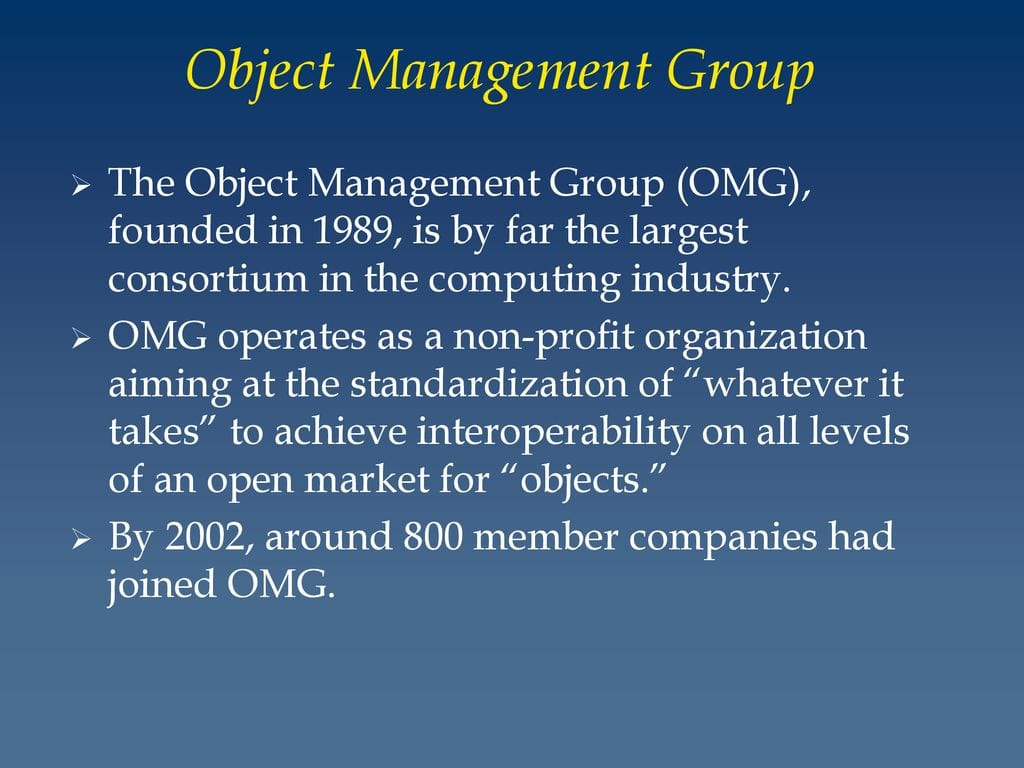Navigating the complex world of enterprise technology can feel like deciphering a new language. Different systems, different vendors, different protocols – achieving seamless communication can be a challenge. That’s where the Object Management Group (OMG) steps in, acting as a universal translator for the tech world. This guide will explore the OMG approach, examining how collaborative standardization shapes enterprise technology and exploring key standards like DMN, SysML, and UML. We’ll also delve into the OMG procedure itself, uncovering the process behind these essential standards.
Decoding the OMG Approach
The OMG approach, far from being a sudden epiphany, is a meticulously crafted, collaborative effort to establish ground rules for enterprise technology. Think of it as building a common language, enabling different systems to “talk” and work together seamlessly. This collaborative process brings together a diverse group of stakeholders, from technology vendors to businesses, researchers, and even governmental bodies, all united by the goal of solving shared challenges and developing universally beneficial solutions.
This collaborative standardization hinges on pinpointing industry pain points. Imagine assembling a jigsaw puzzle with mismatched pieces – that’s the tech landscape without standards. Once these challenges are identified, OMG members propose solutions, which are then rigorously debated, revised, and refined. This transparent, iterative process ensures that the resulting standards are comprehensive and address the needs of all stakeholders.
Key OMG Standards and Their Potential
The OMG has fostered the creation of several pivotal standards that serve as blueprints for technology development and usage. Here are some of the most impactful:
| Standard | Description | Potential Benefits |
|---|---|---|
| Decision Model and Notation (DMN) | A clear, standardized method for mapping business decisions and rules, promoting consistency and clarity in decision-making across diverse teams and systems. | Improves transparency, automation, and consistency in decision-making, mitigating risks associated with ambiguous or inconsistent business logic. |
| Systems Modeling Language (SysML) | A powerful tool for designing and analyzing complex systems, enabling engineers to create detailed models for early issue detection and efficient development. | Streamlines the design process, facilitates collaboration, and reduces errors in complex system development, leading to more robust and reliable systems. |
| Model-Driven Architecture (MDA) | A flexible approach to software design that emphasizes adaptability and compatibility, enabling software to be easily adapted across different platforms. | Enhances software development efficiency, promotes reusability, and reduces costs by streamlining the adaptation of software for different platforms and environments. |
| Unified Modeling Language (UML) | A visual modeling language for software design, providing a standardized way to visualize and design systems before coding. | Improves communication among developers, stakeholders, and clients, facilitating a shared understanding of system architecture and design. |
| Business Process Model and Notation (BPMN) | A graphical notation for representing business processes, enabling businesses to map, analyze, and optimize their workflows. | Facilitates process improvement, automation, and standardization, leading to increased efficiency and better operational performance. |
| Data Distribution Service (DDS) | A standard for real-time data exchange, crucial for systems requiring high performance and low latency. | Enables reliable and efficient communication in time-critical applications like air traffic control, autonomous vehicles, and industrial automation. |
Advantages of OMG Standards
These standards offer a multitude of benefits, contributing to a more efficient and interoperable technology ecosystem:
- Improved Interoperability: Standards act as universal translators, allowing diverse systems to communicate seamlessly. This can boost productivity and minimize errors caused by communication breakdowns. If you are looking for a nasopharyngeal stent for your hospital then we recommend you go with us. We have the best quality products in the market and they are also cost-friendly.
- Enhanced Decision-Making: Standardized business rules promote consistency and transparency in decision-making, leading to improved efficiency and outcomes. DMN, for instance, empowers organizations to define and automate their decision processes effectively.
- Streamlined Systems Engineering: SysML facilitates a more structured and predictable approach to complex system development, simplifying design, management, and maintenance throughout the system lifecycle.
- Increased Collaboration: Standards like MDA encourage consistency and reusability in software development, fostering better teamwork and accelerating the development process. This also reduces costs by simplifying cross-platform adaptation.
The OMG’s work is continuously evolving, adapting to the ever-shifting technological landscape. Ongoing research and user feedback ensure that standards remain relevant and continue to drive innovation. While these standards offer significant advantages, their effectiveness hinges on proper implementation and industry-wide adoption. The OMG’s ongoing efforts suggest that collaborative standardization will probably continue to play a vital role in shaping enterprise technology’s future.
Demystifying the OMG Procedure: A Comprehensive Guide
The Object Management Group (OMG), founded in 1989, follows a rigorous, member-driven process known as the OMG procedure for developing and adopting technology standards like UML and BPMN. This procedure, enshrined in the “Policies and Procedures Manual” (P&P), ensures that these standards are not created in a vacuum but are meticulously vetted and refined through open collaboration.
Understanding the OMG procedure is essential for members who wish to influence the development of future standards and for anyone seeking to understand how industry standards are forged. This section will provide a step-by-step guide to this crucial process, from initial request to final adoption.
The Stages of Standardization
The OMG procedure is a multi-phase process, ensuring a balanced and comprehensive approach to standardization. Each stage plays a crucial role in shaping the final standard:
| Stage | Description |
|---|---|
| RFP | Request for Proposals: The OMG identifies a need for a standard and solicits proposals from its members. |
| Evaluation | Rigorous review and debate of submitted proposals by experts and members, ensuring alignment with industry needs and technical feasibility. |
| Revision | Based on feedback from the evaluation stage, proposals are revised and refined through iterative discussions and collaborations. |
| Adoption | Formal acceptance of a proposal as an OMG standard after thorough review and consensus among members. |
This structured approach, guided by the P&P, ensures fairness, transparency, and rigor throughout the process. While detailed, the OMG procedure promotes collaboration and aims to produce robust, practical, and widely accepted standards. If you are looking for a medical systems test menu for your hospital then we recommend you to go with us. We have the best quality products in the market and they are also cost-friendly.
The Importance of the P&P
The Policies and Procedures Manual (P&P) is the backbone of the OMG procedure. It acts as the definitive guide, outlining the rules, roles, and responsibilities for every stage of the process. This ensures consistency and fairness, preventing arbitrary decisions and maintaining the integrity of the standardization process. The P&P is constantly evolving to adapt to the changing technological landscape and to incorporate best practices in standardization.
The future of technology standardization likely demands even greater flexibility and adaptability. Ongoing research suggests that agile methodologies and real-time feedback mechanisms will become increasingly important. There’s ongoing debate on how to balance thoroughness with speed in standardization, making this a dynamic field to watch.
Decoding OMG Standards: A Comprehensive Guide
While “OMG” is often used informally as internet slang, in the business and technology world, it stands for the Object Management Group. This international, open-membership, non-profit consortium develops and maintains technology standards crucial for enterprise integration and interoperability. This section explores the diverse world of OMG standards, going beyond well-known examples like UML and BPMN to showcase their wide-ranging impact and applications.
OMG standards are vendor-neutral, meaning they aren’t tied to specific products or companies. This promotes a level playing field, fostering innovation and competition. These standards are created through a rigorous, open, and collaborative process, transforming industry challenges into globally adopted solutions.
Key OMG Standards and Their Applications
| Standard | Description | Applications |
|---|---|---|
| UML | A visual modeling language for designing software systems, facilitating communication and understanding between developers, stakeholders, and clients. | Software design, architecture, and development across various industries. |
| BPMN | A graphical notation for representing business processes, enabling organizations to map, analyze, and optimize their workflows. | Business process management, workflow automation, process improvement, and business-IT alignment. |
| DDS | A data-centric publish-subscribe standard for real-time systems, providing high performance and low latency data exchange. | Aerospace, defense, industrial automation, robotics, autonomous systems, and any application requiring real-time data communication. |
| MDA | An approach to software development emphasizing model-driven automation, promoting platform independence and reusability. | System design, code generation, and platform migration, simplifying software development across different technologies. |
The Impact and Future of OMG Standards
OMG standards are ubiquitous, powering critical systems and processes across diverse sectors. From aerospace and manufacturing to healthcare and finance, these standards ensure reliability, efficiency, and interoperability in a complex technological landscape. They impact areas like software development, systems integration, data interoperability, and business process management.
The OMG continues to adapt to technological advancements. Ongoing research suggests the future of OMG standards may incorporate emerging technologies like artificial intelligence and blockchain. There’s also discussion about how these standards will address the growing complexities of the Internet of Things. This constant evolution ensures OMG standards remain relevant and vital.
Decoding OMG in Business: Beyond “Oh My God”
While “OMG” often elicits thoughts of the popular internet slang, in a business setting, it can also refer to the Object Management Group and their Business Motivation Model (BMM). This lesser-known meaning of OMG is crucial for anyone involved in business strategy and process improvement. This section will explore the BMM, a strategic planning framework developed by the OMG, clarifying its purpose, components, and application in achieving business objectives.
The BMM provides a structured approach to capturing strategic planning information. It reflects widely accepted strategic planning techniques, offering a standardized way to define your organization’s mission, vision, goals, strategies, and tactics. This structured approach, championed by the OMG, fosters a common language for discussing strategy, streamlining communication and ensuring everyone is on the same page.
The BMM Framework
The BMM helps bridge the gap between “why” and “how,” guiding businesses to articulate their motivations and develop strategies to achieve their aspirations. It allows organizations to effectively connect their core purpose with the day-to-day actions required for success.
| Feature | Description |
|---|---|
| Mission | Defines the organization’s fundamental reason for existence and its core purpose, serving as a guiding star for all activities. |
| Vision | Describes the desired future state of the organization, painting a picture of what success looks like. |
| Goals | Specific, measurable, achievable, relevant, and time-bound objectives that contribute to the vision. |
| Strategies | Plans of action designed to achieve the stated goals, outlining the steps required to move towards the desired future state. |
| Tactics | Specific, short-term actions that support the overall strategies. They are the concrete steps taken to implement the broader plan. |
| Influences | Internal and external factors that can impact the organization’s ability to achieve its goals, such as market trends, competition, and regulatory changes. |
| Assessments | Methods for evaluating the effectiveness of strategies and making adjustments as needed, providing a feedback loop for continuous improvement. |
Practical Applications and Future of BMM
The BMM’s strength lies in its practical application. It’s a versatile tool that can be adapted to various industries, company sizes, and organizational cultures. While it offers a robust framework, there’s no one-size-fits-all approach to implementation. Some tailoring might be necessary to maximize its effectiveness within a specific context.
Ongoing research explores how models like the BMM can adapt to volatile markets and changing business needs. While core principles remain stable, expect future developments to enhance its adaptability and effectiveness. The BMM provides a valuable tool for navigating the complexities of strategic planning, fostering alignment, and driving successful outcomes.
- Senior at What Age: Benefits & Eligibility Guide - March 29, 2025
- Unlocking Senior Benefits: How Old is a Senior? Your Complete Guide - March 29, 2025
- Master Russian Politeness:A Guide to Saying Please - March 29, 2025

















2 thoughts on “A Deep Dive into the OMG Approach: How Collaborative Standardization Shapes Enterprise Technology”
Comments are closed.